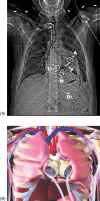Implantable mechanical circulatory support: demystifying patients with ventricular assist devices and artificial hearts
- PMID: 21308692
- PMCID: PMC6652496
- DOI: 10.1002/clc.20825
Implantable mechanical circulatory support: demystifying patients with ventricular assist devices and artificial hearts
Abstract
Engineering advancements have expanded the role for mechanical circulatory support devices in the patient with heart failure. More patients with mechanical circulatory support are being discharged from the implanting institution and will be seen by clinicians outside the immediate surgical or heart-failure team. This review provides a practical understanding of device design and physiology, general troubleshooting, and limitations and complications for implantable left ventricular assist devices (pulsatile-flow and continuous-flow pumps) and the total artificial heart.
© 2011 Wiley Periodicals, Inc.
Figures





Similar articles
-
Current Role of the Total Artificial Heart in the Management of Advanced Heart Failure.Curr Cardiol Rep. 2019 Nov 22;21(11):142. doi: 10.1007/s11886-019-1242-5. Curr Cardiol Rep. 2019. PMID: 31758343 Review.
-
Evaluating heart failure after implantation of mechanical circulatory support devices.Curr Heart Fail Rep. 2012 Mar;9(1):65-74. doi: 10.1007/s11897-011-0079-z. Curr Heart Fail Rep. 2012. PMID: 22135186 Review.
-
Durability of left ventricular assist devices: Interagency Registry for Mechanically Assisted Circulatory Support (INTERMACS) 2006 to 2011.J Thorac Cardiovasc Surg. 2013 Aug;146(2):437-41.e1. doi: 10.1016/j.jtcvs.2013.02.018. Epub 2013 Mar 13. J Thorac Cardiovasc Surg. 2013. PMID: 23490245
-
A review of implantable pulsatile blood pumps: Engineering perspectives.Int J Artif Organs. 2020 Sep;43(9):559-569. doi: 10.1177/0391398820902470. Epub 2020 Feb 10. Int J Artif Organs. 2020. PMID: 32037940 Review.
-
Cardiac prosthesis as an advanced surgical therapy for end-stage cardiac patients: current status and future perspectives.J Med Dent Sci. 2000 Sep;47(3):151-65. J Med Dent Sci. 2000. PMID: 12160228 Review.
Cited by
-
Reciprocal interferences of the left ventricular assist device and the aortic valve competence.Front Cardiovasc Med. 2023 Jan 9;9:1094796. doi: 10.3389/fcvm.2022.1094796. eCollection 2022. Front Cardiovasc Med. 2023. PMID: 36698950 Free PMC article. Review.
-
Rotary mechanical circulatory support systems.J Rehabil Assist Technol Eng. 2017 Sep 1;4:2055668317725994. doi: 10.1177/2055668317725994. eCollection 2017 Jan-Dec. J Rehabil Assist Technol Eng. 2017. PMID: 31186935 Free PMC article.
References
-
- Taylor DO, Stehlik J, Edwards LB, et al. Registry of the International Society for Heart and Lung Transplantation: twenty‐sixth Official Adult Heart Transplant Report—2009. J Heart Lung Transplant. 2009;28:1007–1022. - PubMed
-
- Rose EA, Gelijns AC, Moskowitz AJ, et al. Long‐term use of a mechanical left ventricular assist device for end‐stage heart failure. N Engl J Med. 2001;345:1435–1443. - PubMed
-
- Dembitsky WP, Tector AJ, Park S, et al. Left ventricular assist device performance with long‐term circulatory support: lessons from the REMATCH trial. Ann Thorac Surg. 2004;78:2123–2130. - PubMed
-
- Miller LW, Pagani FD, Russell SD, et al. Use of a continuous‐flow device in patients awaiting heart transplantation. N Engl J Med. 2007;357:885–896. - PubMed
-
- Pagani FD, Miller LW, Russell SD, et al. Extended mechanical circulatory support with a continuous‐flow rotary left ventricular assist device. J Am Coll Cardiol. 2009;54:312–321. - PubMed
Publication types
MeSH terms
LinkOut - more resources
Full Text Sources
Medical

